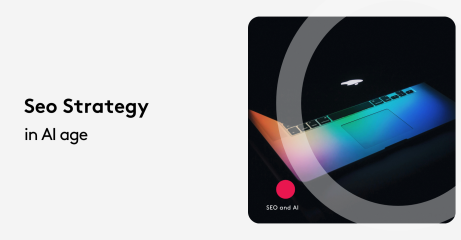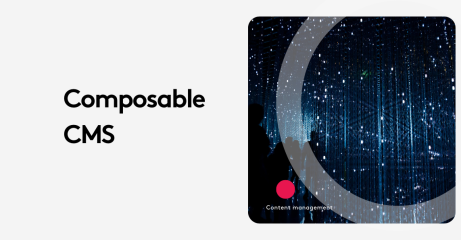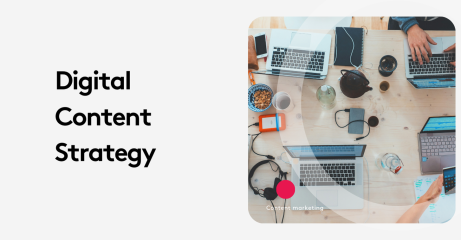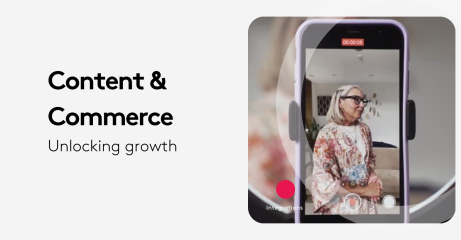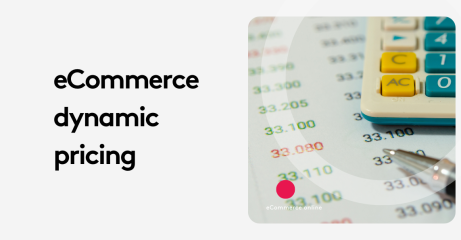7 Idiot-Proof Ways To Position Your Agency For Ultimate Growth
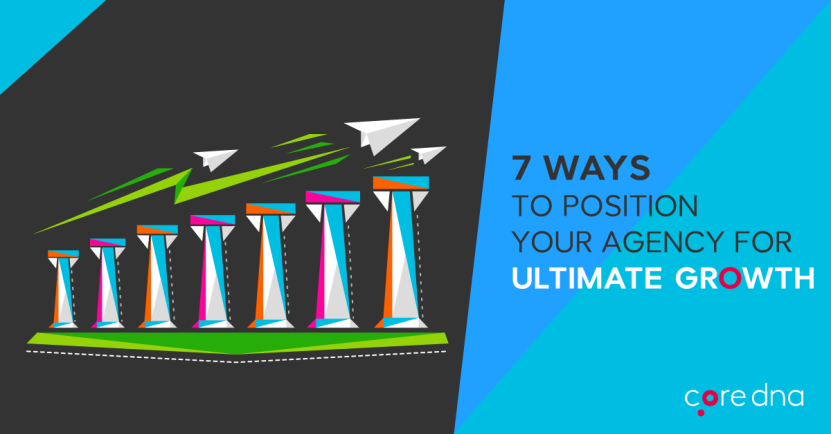
If you’re running an agency, what keeps you up at night are probably an overly demanding client with unrealistic expectations and how to get more leads. Not to mention the need to keeping up to date with the latest tactics, prioritizing marketing for your clients AND your business.
In this post, I’ll share some strategies and tactics you can use in your digital agency to position your agency for MASSIVE growth.
On this page:
1. Position yourself to limit resistance
Unrealistic client expectations are often a matter of poor client-agency fit. If you position yourself as an “affordable” agency, don’t be surprised when clients question every billed hour and demand out of scope work for free. One way to solve this problem is to position your agency in a way that limits client objections. This will also help you get the kind of clients you actually want to work with.
So how can you use positioning to manage client expectations?
Here are two tactics:
A. Focus your brand storytelling on things that actually matter to clients
There is often a big disconnect between what agencies think is important for their brands and what clients actually care about. To give you an example, take a look at this chart:
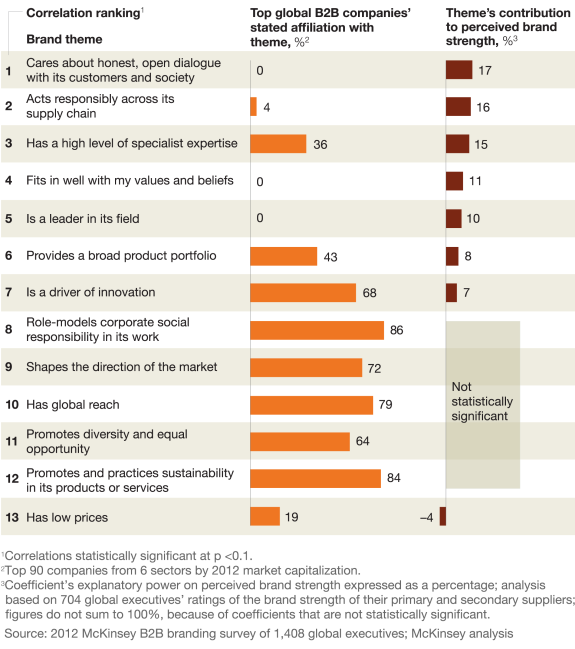
This is from a McKinsey study of 90 B2B companies across 6 sectors. The study highlights how companies often focus on brand themes (such as “low prices” or “global reach”) that don’t have any net impact on their actual brand perception.
At the same time, brand themes that actually contribute to brand strength - specialist expertise, transparency, etc. - get ignored.
For your agency, ask yourself whether you’re actually promoting brand themes that clients care about in your storytelling. If you’re focusing too much on themes such as “affordability”, there is a good chance you’re missing out on clients who look past low prices.
The best way to figure out what clients care about is to simply ask them and change your brand accordingly. But for starters, you can go with the findings from this survey asking agency clients what they look for in agency partners:
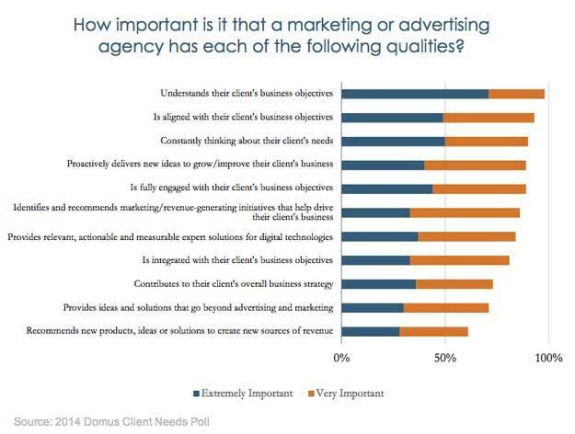
Try to incorporate these issues into your brand storytelling.
B. Emphasize expertise instead of covering every solution
Most agencies cover the entire bouquet of digital services, from strategy to design to development to SEO/SEM to content to social ...
On paper, this sounds like a good idea. After all, if you offer more services, you’re likely to attract more clients (the “cast your net wide to catch more fish” argument). The problem with this approach is that clients usually want topic expertise instead of generic knowledge. In one survey of 150 marketers, 20% of respondents said that they looked for industry expertise when choosing a new agency.
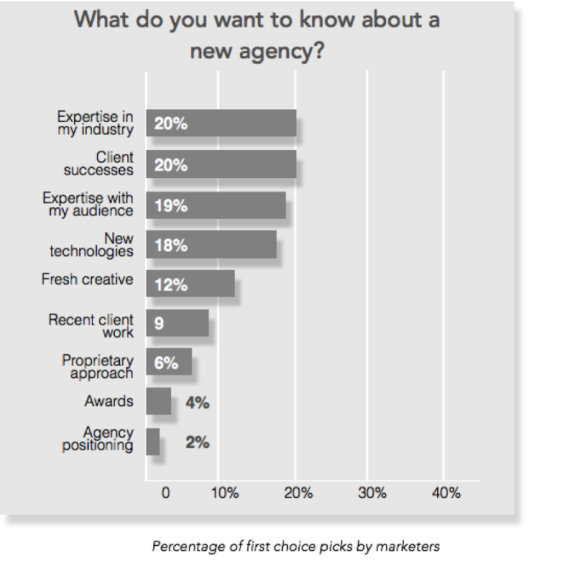
In real-world terms, instead of spreading yourself thin, cover only a limited set of services and demonstrate expertise in them.
2. Know your costs and pricing inside out
How much does an extra hour of copywriting work cost you? What’s the charge for hiring a freelancer to wrap up an infographic in five hours? If a client requests out of scope work, how much of a hit will you take in all the unbilled hours?
For agencies, knowing the answers to these questions is the key to profitability. It is also the key to keeping your clients and your accountant happy.
Picture this: an unhappy client demands a complete revision to a landing page. You quickly calculate that the revision will require 5 hours of design work, 2 hours of copywriting and 5 hours of development.
If you know your pricing inside out, you can figure out how much the entire revision will cost you. You can then choose to continue or drop the client based on how much the revisions will impact your profitability.
The question now is: how do you calculate your costs and profit margins for each resource?
Here’s how:
A. Calculate resource cost per hour
The first step is to calculate how much each resource costs your hourly. Here’s how you can do this:
- Calculate the total annual cost for each resource (including gross salary, insurance, benefits and other expenses)
- Calculate total number of hours each resource is available to work in a year (exclude weekends, public holidays, sick days and vacation time).
- Divide total annual cost per resource by total number of available hours
For example, if you pay your designer $50,000 in salary and an additional $15,000 in benefits/expenses, your total cost would be $65,000. If this designer is available to work for 40 hours each week for 46 weeks (including 2 weeks each of public holidays, sick leaves and vacation time), you get 1,840 work hours.
Thus your cost for this resource is $35.23/hour ($65,000/1,840).
Do this for all your resources in a separate spreadsheet.
B. Calculate overheads cost per hour
The next step is to calculate how much your overheads (rent, utilities, non-billable hours, etc.) cost on an hourly basis.
To do this:
- Calculate all estimated expenses for the year (including non-billable hours - such as sales or accounting - admin staff salaries, office rent, utilities, entertainment expenses, equipment etc.)
- Calculate overheads cost per hours by dividing your total annual expenses with total available billable hours
For example, suppose you have 10 employees with 1,840 billable hours for the year. Your total annual overheads are $460,000. This means that your overhead cost per hour is $25 ($460,000/18,400).
C. Calculate break-even point for each resource
You now have two things:
- The hourly cost for each resource
- The hourly overhead cost for running the agency
Your breakeven point for each resource would simply be the resource’s cost per hour + your overheads cost per hour.
For example, if a junior designer costs you $50/hour and your overhead cost is $25/hour, your breakeven point would be $75/hour. This means that any out of scope beyond $75/hour would put you in the red.
Keep this information handy at all times. Use it whenever you have to respond to requests for out of scope work. If the request is reasonable enough and can be wrapped up without hurting your profit margins, go ahead and do it. Else, consider firing the client.
3. Set upfront policies before starting work
When you get a new client, it’s tempting to dive head-first into delivering your solutions without clarifying your policies upfront.
Big mistake.
Having clear upfront policies can save you from a lot of “I didn’t know that” objections from clients later on. If you clarify that you charge 25% of the project fee before the first deliverable, you set client expectations right from kickoff.
At the very least, you should have upfront policies for the following:
- Payments: Clarify whether you take upfront payments, the payment schedule, and acceptable modes of payment.
- Scope of work: Scope creep can kill agencies. Identify that you and the client both know exactly what the project involves before you start.
- Out of scope work: State clearly how you will deal with out of scope requests. If you’re going to bill the client for it, state it upfront.
- Contractors working on the project: If you’ll have freelancers working on the project, make sure that clients know about it upfront. Else some might accuse you of sub-contracting your work to a third party.
- Delivery and deadlines: State your delivery schedule, the identified deadlines, and how you propose to deal with missed deadlines.
4. Support pricing with case studies and ROI-focus
For most agencies, pricing is usually the biggest source of client objections. In fact, in one survey, 48% of respondents said that their biggest challenge when closing a deal was being undercut by cheaper competitors.
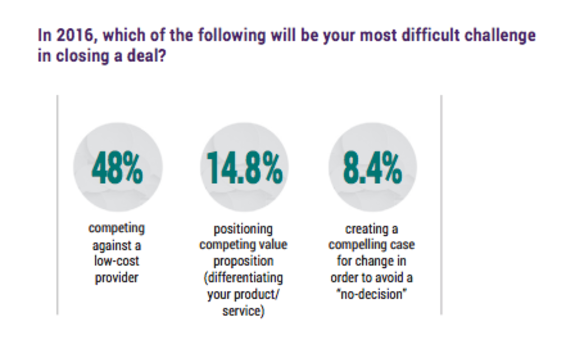
From a client’s perspective, pricing based objections sound reasonable enough. They don’t really know what goes beneath the hood of a digital campaign. They have no way of knowing whether your project will actually make them money.
There are two ways to solve this problem:
- Use value-based pricing where you bill them a % of the revenue you bring in.
- Support pricing with case studies showing ROI
The first solution - value-based pricing - requires a complete retooling of your entire business model. For most agencies, this might be an unattainable goal.
The second solution, however, is easy enough to do and will help mitigate a lot of pricing-based objections.
For example, take a look at how SingleGrain emphasizes ROI on its homepage.
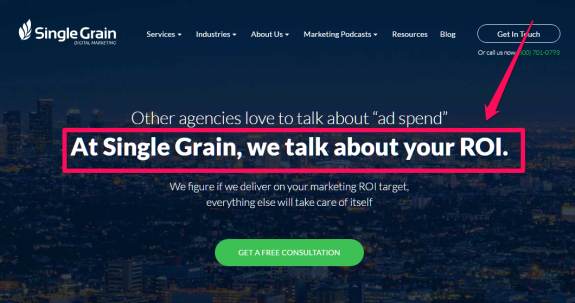
It also features case studies highlighting results in terms of ROI for clients.
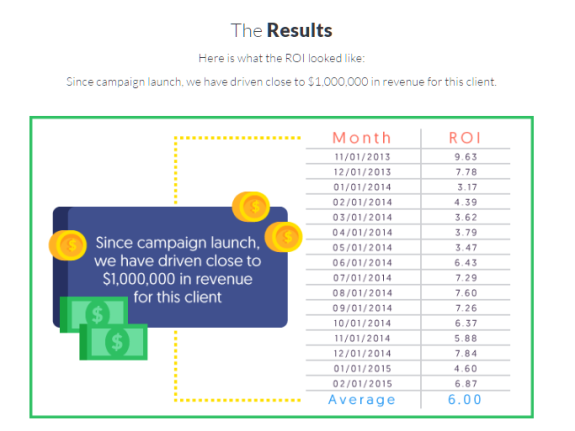
This changes the conversation from “we will do X” to “we will do X to increase your revenue”. Clients might not understand abstract metrics such as lower bounce rate. But they will understand ROI.
5. Audit past work to estimate deadlines
Agencies are often guilty of setting unrealistic deadlines in order to win over clients. The end result is a scenario all too familiar to agency veterans: a last minute rush to complete projects that eventually leads to low morale and high employee attrition.
There is an easy fix to this problem: set more realistic deadlines. To do this, start by auditing your past work. This audit should focus on:
- Scope of work: The total billable and non-billable hours for the project, including any out of scope work.
- Project type: Classify each project into different categories, such as “landing page development”, “blog post”, etc.
- Scheduled deadline: The scheduled deadline as per the project contract
- Delivery date: The actual date of project delivery
This can be a simple spreadsheet that looks like this:

Doing this will tell you the difference between the estimated and the actual delivery date for each project type. You’ll often find that projects take far longer than you estimated and that your scheduled and actual delivery dates are often days apart.
Once you have this data, you can offer clients more realistic deadlines based on past experience, not just a hopeful estimate. To be extra cautious, add in a few extra days of “padding”.
For instance, if you know that your last 5 web development projects took an average of 24 hours each, you can set a deadline that includes enough padding for all 24 man hours of work.
6. Practice transparency in communication
There are two concerns clients have when it comes to agency transparency:
- Clients don’t know what they’re being charged for
- Clients don’t know what’s the status of their projects
Both of these lead to confused clients who don’t know what to expect. In fact, according to one report, a lack of transparency (especially in pricing) is a major cause of trust deficit for agency clients.
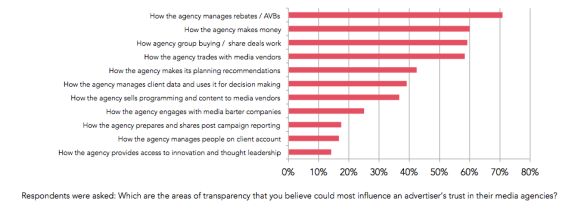
To deal with this problem, here are a few things you can do:
A. Clarify your communication policies in advance
I know there is an implicit pressure to respond to every client request no matter the hour, but you can’t run a business if you have to be at the beck and call of clients at 6AM on a Sunday. Before you start a project, make sure that clients know exactly how you communicate.
In your kickoff deck, include the following:
- Your preferred channel of communication (email, phone, text)
- How quickly you respond to clients (say, within 24 hours)
- Weekend communication policies (say, you’ll take 48 hours to respond to emails sent on weekends)
B. Unify communication and empower employees
Simply giving power to your employees to communicate issues directly will clients will take care of a lot of unreasonable expectations. Your clients are likely to take feedback much more seriously when your lead developer tells them why a technical issue can’t be resolved in 24 hours than when your account manager does the same.
Pool in your communication from multiple channels (Twitter, email, phone, text, Slack) and give employees open access to your unified communication. Encourage them to speak directly with clients as issues arise, especially with technical/creative issues.
C. Offer priority communication channels for urgent issues
Urgent issues, such as the site going down, can and will arise.
To address these issues, it’s important that you give clients access to priority communication channels. In your kickoff deck, include the following:
- What kind of issue is classified as “urgent” (the site going down is urgent; a social media post is probably not).
- Who to contact in case of an urgent issue. Make sure that this contact is a source or reassurance for clients - someone senior with authority to prioritize the issue.
D. Mention issues as they arise
Take a leaf from the agile development playbook and keep an open communication channel with your clients for new issues. Instead of waiting for the finished product, keep clients in the loop by telling them about issues as they arise.
You’ll find that simply being in constant communication with clients about issues will mitigate a lot of unrealistic expectations. When clients know exactly who is working on what, it brings the scope of the project into perspective. Knowing that a developer might end up spending 10 extra hours hunting down a single bug helps place client demands in context.
E. Offer transparent pricing (if possible)
As a final step, consider offering transparent pricing. This will take care of a major reservation client have about agencies (see the graph above).
If you’re going to hire freelancers to work on the project, make sure that clients know about it. For even more transparency, go a step further and tell clients what you’re going to pay these freelancers as well. Similarly, tell your clients about the other people who’ll work on the project, how much they cost, and how long they’ll take to finish the project.
Clients understand that you’re running a business, and that keeping 10-20% of margins on each project (excluding your costs) is reasonable enough. With transparent pricing, you’ll make up the trust deficit and turn your clients’ expectations a bit more realistic.
7. Adopt an agile approach to selling aka “Foot in the Door” technique
Every agency would love to land a six-figure contract with a marquee client. The trouble is, the length of the sales cycle, the number of decision makers, and client expectations rise proportionately with the value of the contract.
Not to mention that large projects have complex requirements that take forever to understand. Instead of this “waterfall” approach, adopt an “agile” approach to selling.
This means chasing smaller projects that get your foot in the door at large clients. Once you wrap up a smaller project, collect feedback from clients and push ahead for another, slightly larger project. Rinse and repeat.
This agile “foot in the door” approach takes care of a lot of objections and unreasonable client expectations. With a six-figure project, your client will naturally demand more, but for a $4-8k project, you will likely have a free rein to deliver your best work.
Further, when you go slowly from small to big projects, you already have an established body of work with the client. This means that when you finally do close that six-figure project, the client already knows what you’re capable of and how you work.
This helps reduce unrealistic expectations since both you and the client can look to your past history to address future concerns.
Here’s how you can make this agile approach to selling work for you:
A. Figure out your best foot in the door offer
Understand that your objective with your foot in the door offer is to:
- Win the client’s trust
- Demonstrate expertise
- Set the tone for the rest of the relationship
Ideally, your foot in the door offer should have two characteristics
- It must be something you excel at (and have the case studies to back up the claim)
- It must be something that can deliver immediate ROI to the client
Try to offer something you excel at but which the client has little to no knowledge of. You want to wow them with the results in this first interaction (without setting expectations too high).

B. Under promise and over deliver
Remember that your first project with a client will set the tone for the rest of the relationship. If you overpromise in this project, your clients will expect the same for all future projects as well.
The result? Demanding clients with unrealistic expectations.
To solve this problem, under promise the results in your first “foot in the door” project. Since client expectations are already low, you can deliver quality work without setting the stage for unreasonable demands in the future.
Over to You
There you have it, the 7 pillars to position your agency from a ‘barely made it’ agency to an ‘uber-successful’ agency.
Here’s to creating the next big digital agency! Is there anything you’d like to add? Do you agree or disagree? Let me know in the comments.


